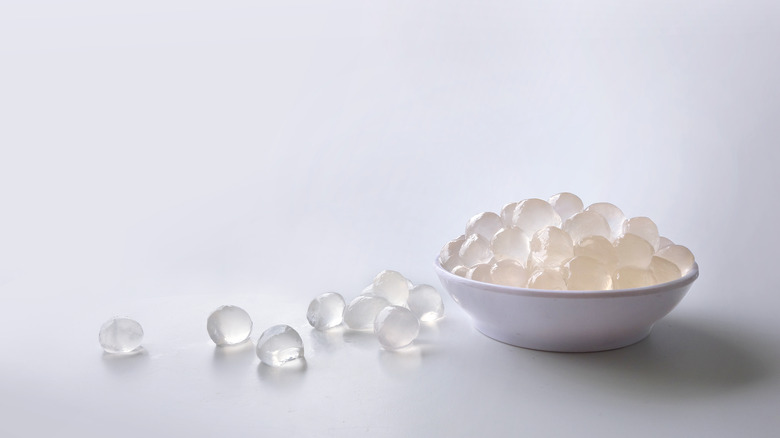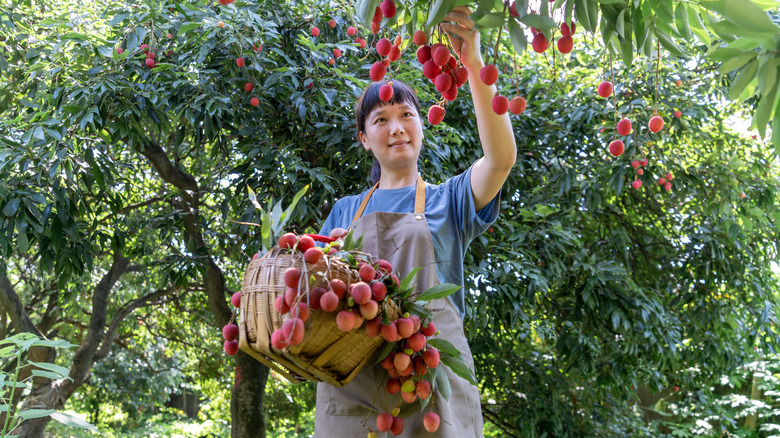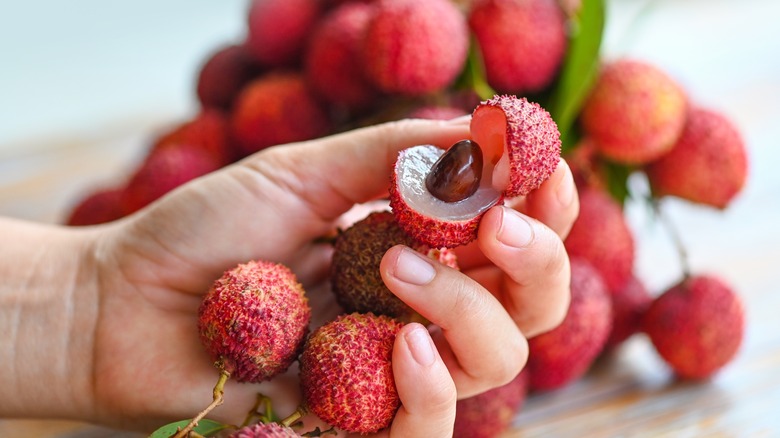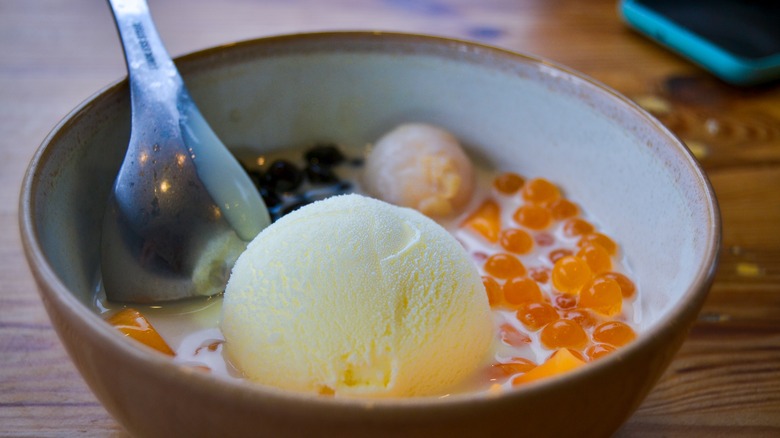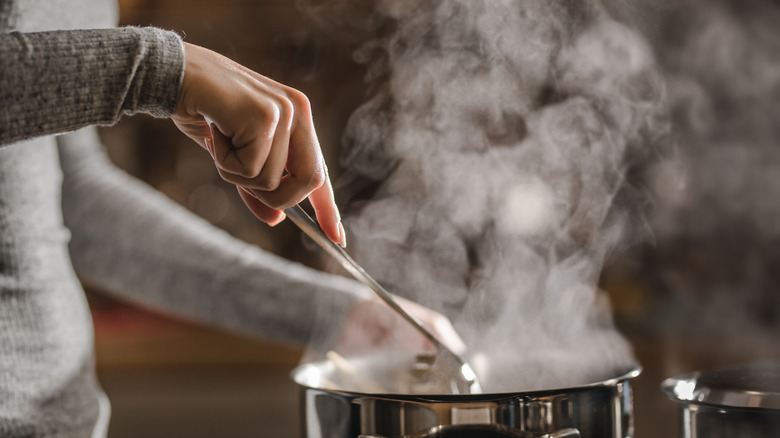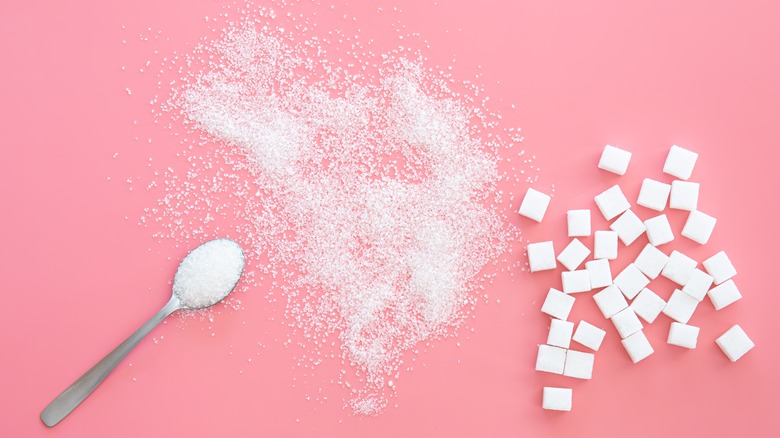Lychee Jelly Adds A Jiggly Burst Of Tropical Flavor To Bubble Tea And Beyond
Milk tea shops are known for their myriad of menu items. You may be familiar with many customizations, such as adding boba or adjusting sweetness levels, but may also remain overwhelmed by the dozens of other options. One addition that is lesser-known in the United States is lychee jelly. This jiggly, fruit-based ingredient brings a bright pop of flavor wherever it is used, and we highly recommend enjoying it in your milk tea and beyond.
Lychee jelly is a pale white, translucent sweet that has a gelatinous appearance and texture. It is made in large batches and shaped into cubes, spheres, or sometimes more artistic shapes like stars. In the U.S., you are most likely to see it in bubble tea or boba shops, where it can be added to any drink of your choosing for a refreshing twist. It is one of many fruit jellies of its kind, alongside flavors like coconut, mango, and passionfruit.
What is lychee?
Lychee, also known as the Chinese cherry, is from the soapberry trees that originated in the forests of southern China. They are known for their reddish, leathery skin and soft white interior, as well as their delectable flavor. The fruit has been valued for thousands of years among the Chinese people, especially in prominent Chinese families. The fruit gained further notoriety in the 1800s, when emigrants spread the trees across the world and they reached as far as places like India, South Africa, Jamaica, and even Florida.
Today, lychee fruits are readily available worldwide, even in cold climates. While they can be enjoyed fresh, they are often used as a flavoring for sweets, beverages, and desserts, such as lychee soda and lychee hard candies. Arguably the most popular confection using lychee as its flavoring, however, is the aforementioned lychee jelly thanks to how easy it is to make and enjoy in a wide variety of recipes.
What does lychee jelly taste like?
Lychee jelly tastes very similar to the fruit from which it derives its flavor. It is sweet and tropical with mild floral notes. Like many so-called exotic fruits, it is often compared to a combination of other produce — in the case of lychee jelly, that combination tends to be a blend of melon, plum, and pear. The jelly can taste sweeter than the fruit itself due to the addition of sugar during its making.
It is no surprise that the jelly is jiggly, translucent, and soft like most other jellies. It is, however, slightly more firm than gelatin-based products like Jell-O and is closer in consistency to desserts like flan or panna cotta. This is because lychee jelly is typically made using natural coconut gel, or nata de coco, as a thickener. And luckily for some, this means that lychee jelly is vegan in most cases.
How to use lychee jelly
Lychee jelly is a versatile ingredient that is traditionally used in both foods and beverages. Common drinks it is featured in include the aforementioned milk tea, as well as in green tea and iced coffee. We also recommend experimenting with it as an interesting textural component in cocktails, as a splashy visual upgrade in a bowl of punch, or even as a way to make a glass of lemonade more fun, fruity, and refreshing.
When it comes to food, the jelly is most commonly eaten on its own out of pre-packaged cups. These lychee jelly cups can be enjoyed whole in a single bite, eaten with a spoon, or frozen and treated like a popsicle. Other traditional uses include as a topping for cold desserts like ice cream and shaved ice. It can also act as a filling for cakes, a garnish for breakfast items like pancakes and toast, or even a surprising mix-in to yogurt or açai bowls.
How to make lychee jelly
Lychee jelly can either be purchased or cooked at home. Pre-made lychee jelly is not often found at American grocery stores, so we recommend visiting a grocery store that specializes in carrying food common to Asian cuisine, where it will be sold in both single-serving packages and in bulk. You can also buy lychee jelly from websites like Amazon and Bossen, a vendor for milk tea ingredients and toppings.
If you prefer to make your own jelly, you will need lychee pulp, coconut water or milk, sugar, and nectar. In places where nata de coco is difficult to obtain, agar agar powder is the favored substitute. Dissolve the thickener and sugar in boiling water, add the lychee, then pour into a baking pan and let it set in the fridge. Once set, you can cut the jelly into cubes or any other shape you would like, and enjoy.
Storing lychee jelly
Whether you prefer to use pre-made or homemade lychee jelly, it must be stored properly in order for it to last as long as possible. This delicate ingredient is both heat and moisture-sensitive. As such, unopened store-bought containers must be kept in a cool, dry place like a pantry or basement, where it can last for up to 18 months; however, once opened this ingredient must be refrigerated. Whether store-bought or made fresh, refrigerated lychee jelly will last anywhere from three days to two weeks.
If the jelly smells unpleasant, grows mold, or changes drastically in color, assume it has spoiled. While you may be tempted to freeze your lychee jelly to extend its shelf life, note that it is not recommended unless you intend to eat it while frozen, as doing so will change the texture of the thawed product.
Lychee jelly nutrition
Lychee fruit contains a fair amount of vitamins, like most fruits. Predominantly, lychees have significant amounts of vitamin C as well as potassium; however, these nutritional benefits are likely negligible in lychee jelly, as the fruit is used more for flavoring than to add substance to the jelly. On the other hand, nata de coco and agar agar, both of which can be used to create lychee jelly, are high in soluble fiber, which can act as an aid for digestion and gut health.
It is worth noting that lychee jelly can be quite high in sugar content. This is due both to the naturally high sugar of the lychee fruit as well as the added sugar in the creation of the jelly. While it is still a perfectly acceptable treat for many in moderation, just like any dessert, those with diabetes and other sugar tolerance issues should enjoy this ingredient with caution.
